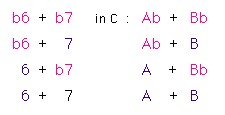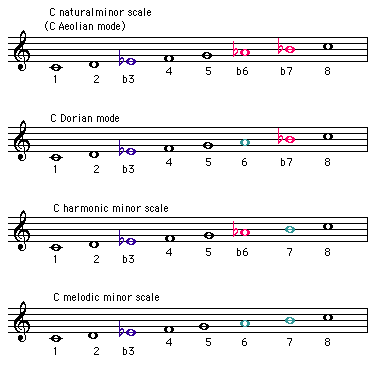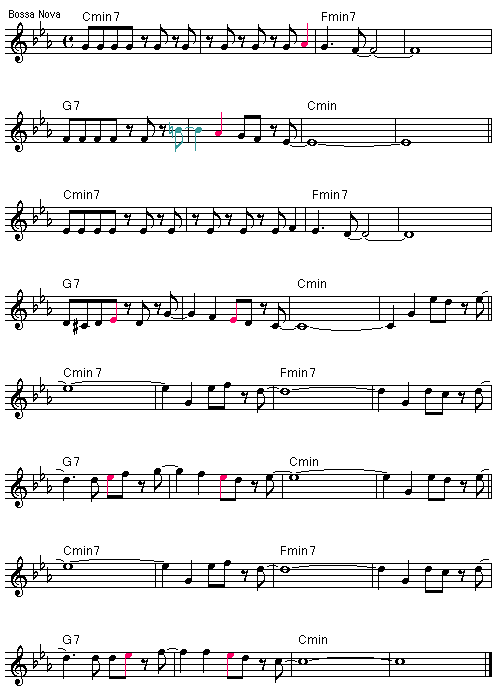(Down - Top)
Im 8.1 - About Minor scales
The Dorian mode is the most commonly used minor scale for Jazz improvisation, especially over isolated minor 7th chords and in so called 'IIm7 - V7' chord combinations (more about this in Lesson 10).
But there are other minor scales that are at times preferable, especially when the song is in a minor key.
A minor scale can be defined as a scale that contains a minor triad chord as its tonic chord ( in C : C Eb G).
In other words the scale must contain (measured from the tonic note) :
- a minor 3rd (b3 = Eb for a C minor scale)
- a perfect 5th (p5 = G for a C minor scale)
- it must not contain a major 3rd (3 = E for a C minor scale)
Apart from the above anything else goes.
The most common minor (7 tone-) scales in both Jazz and Classical music have the first five notes of the scale in common (1 2 b3 4 5) but vary in the choice of their 6th and 7th note.
There are four different combinations possible :
 This produces four different minor scales :
This produces four different minor scales :
Audio 8.1
 The natural minor scale (also called 'Aeolian mode') is like the Dorian mode a displaced major scale.
It is a scale that starts on the 6th note of a 'related' major scale.
The natural minor scale (also called 'Aeolian mode') is like the Dorian mode a displaced major scale.
It is a scale that starts on the 6th note of a 'related' major scale.
Audio 8.2

The key signature for any minor key is the one taken from its natural minor scale. The key signature of a natural minor scale is the same as its related major scale.
For C minor key :
The C natural minor scale is derived from the Eb major scale, which has three flats (Bb, Eb and Ab). The key signature for C minor has therefore also three flats.
The harmonic minor scale (with b6 and 7) and the melodic minor scale ( with 6 and 7) are not displaced major scales. One or two of their notes are simply altered from the natural minor scale.
-
When you are READING music notation : think of the the harmonic minor scale as a natural minor scale with a raised 7th.
-
When IMPROVISING it is perhaps easier to imagine the harmonic minor scale as a major scale with a lowered 3rd (b3) and a lowered 6th (b6).
-
When you are READING music notation : think of the the melodic minor scale as a natural minor scale with a raised 6th and 7th.
-
When IMPROVISING it is perhaps easier to imagine the melodic minor scale as a major scale with a lowered 3rd (b3) only.
Modes of the melodic minor scale are especially used for improvisation over altered dominant chords.
The other three minor scales are often used in songs in minor keys.
Sometimes all three can be used in the same song like in
(Down - Up - Top)
Im 8.2 - Where there's Rain . . . (Song)
'Where there's Rain' is a medium tempo Bossa Nova in the key of C minor.
Play therefor all quavers 'straight'.
This is a 32 bar song in AB format. The A section is the first 16 bars, the B section the last 16 bars.
Within each section the rhythm of the melody for the first 8 bars and second 8 bars are similar and the chord progressions are exactly the same.
Audio 8.3

Where there's Rain : Demo -
Swapping 4s.
- 1st chorus (32 bars) : I play the first 4 bars of each 8-bar segment, you play the following 4 bars.
- 2nd chorus (32 bars) : You play the first 4 bars of each 8-bar segment, I play the following 4 bars.
I start a new phrase in 'your 4th bar' on a number of places, or start a phrase late in 'my own 1st bar'. You can do the same of course.